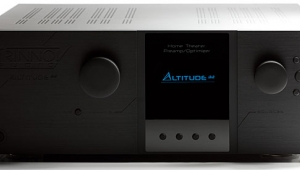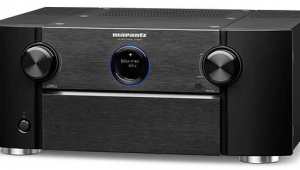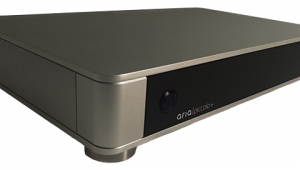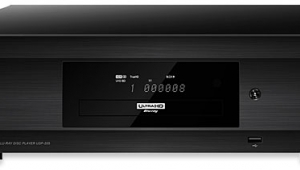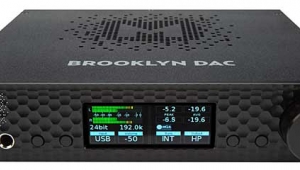| Columns Retired Columns & Blogs |
Music in the Round #37 Page 2
Last but not the least is the Blue Echo Solutions hd EZ lock, which firmly locks a conventional HDMI cable to the chassis socket ($20/pair). Installation of this gadget was a bit fiddly, and required manipulation of small parts in tight quarters. However, while it permits the replacement of cables (with a hex key!) and can itself be removed, the hd EZ lock is not intended for quick and casual cable swapping. Conversely, it did afford the most firmly secure HDMI connection, while still giving me complete freedom of choice in cable selection. This I like.
Footnote 1: For the main channels, the 30 filters (Q=3.65) are at 1/3-octave ISO intervals: 25, 31, 40, 50, 63, 80, 100, 125, 160, 200, 250, 315, 400, 500, 630, and 800Hz, and 1, 1.25, 1.6, 2, 2.5, 3.15, 4, 5, 6.3, 8, 10, 12.5, 16, and 20kHz. For the subwoofer channel, the 20 1/6-octave filters (Q=6) are at 20, 23.9, 25.6, 29.9, 33.4, 37.4, 41.4, 47.2, 53.3, 59.5, 67.1, 75.8, 85.6, 96.6, 109, 123.1, 139, 157, 177.1, and 200Hz.
In fact, I like every one of these products. They've convinced me that I need the added reassurance of the firm connections they offer. At one end of the spectrum, the PPC Locking cable is ideal for those who frequently swap out equipment. Just use them as ordinary HDMI cables that are a lot less likely to lose connection. At the other end is the Blue Echo hd EZ lock. I'm certain (I haven't tried it) that I could hang my Blu-ray player from an hd EZ locked HDMI cable, as long as the cable itself was up to the task. Probably the best choice for most people are the Gefen and Xantech cables, with which I, for one, am replacing all of my HDMI connections. Never again will I have to wiggle or reseat an HDMI cable.
Neptune Audio neptuneEQ
Except for those rare listening rooms that have been designed by acoustical engineers, I think room equalization is virtually essential for the reproduction of multichannel recordings. I've used the room-EQ systems made by Audyssey, Meridian, Rives, and TacT, all of which use various implementations of multiple parametric filters. With parametric filters, the frequency, Q (sharpness), and magnitude of the boost/cut are independently tuneable.
Neptune Audio's neptuneEQ ($3995) is different. It has an eight-channel graphic equalizer with fixed frequency and Q for each of its filters (30 filters spaced at 1/3-octave intervals on the seven main channels; 20 spaced at 1/6-octave intervals on the ".1" channel, footnote 1). This at first made me a bit leery, but two other features were attractive. First, the neptuneEQ requires no external devices other than a microphone (provided). Second, it directly implements corrections for channel levels and distances. This makes it ideal for those using a multichannel analog preamplifier with few or no controls for these parameters. Think of the neptuneEQ as a room equalizer bundled with a DSP version of the erstwhile Outlaw Audio ICBM (see my review in the December 2003 Stereophile). Currently, I'm enjoying Parasound's P-7 preamplifier as the center of my system; the neptuneEQ seemed an entirely apt partner.
Because the neptuneEQ operates in the digital domain, it includes A/D conversion of the analog inputs and D/A conversion to its analog outputs, both at 24-bits/96kHz. RCA (unbalanced) and XLR (balanced) connections are provided. The neptuneEQ can be automatically set using its microphone, then manually tuned. In addition to equalization, the neptuneEQ also controls bass management (a 4th-order Linkwitz-Riley crossover at the same frequency), and provides settings for channel level and delay. Again, all of these can be automatically set and manually modified. In addition, the neptuneEQ has tone-control options, and several preprogrammed modes that are, essentially, tone-control presets. All in all, the neptuneEQ provides all the bells and whistles that would be lacking in a system based on a straight-through analog preamp instead of a digital preamplifier-processor.
I used the neptuneEQ's balanced inputs and outputs to insert it between the Parasound P-7 and my power amplifiers, and followed the instructions for auto setup. I snaked the mike cable through the little beanbag that Neptune provides in lieu of a mike stand, and propped up the mike in an approximation of my listening position. The neptuneEQ's software requires precisely five measurement positions, and prompts the user to move the mike between tests, then to get out of the way. The tone bursts are harsher and louder than I was prepared for, and their sequence surprised me. Not only was each speaker in the system tested for each mike position, but on each pass the neptuneEQ also bounced the tones back and forth between adjacent speaker channels. Even so, the entire procedure went very quickly, in comparison with how long Audyssey's MultEQ Pro took to test for the same number of mike positions. Tests completed, the neptuneEQ performed its calculations and was ready to go in seconds.
Before numerically examining what the neptuneEQ had done, I listened to the results. With test material limited to the front left and right channels, it was apparent that the neptuneEQ hadn't changed the system's tonal characteristics. Compared with the bypass mode, I detected a slight brightening in the treble that aided the clarity of textures with some recordings, and the bass seemed cleaner and tighter, though not by much. I couldn't detect that my JL Audio Fathom f113 subwoofer was doing anything, although its auto-on LED was lit. The neptuneEQ chose to cross over to the sub at 75Hz for all channels, but despite this relatively high setting, the Fathom was always totally unlocalizable by ear. In short, the neptuneEQ did little or no harm to the sound, even while passing the audio signal through three additional circuits: A/D, DSP, and D/A. With multichannel sources—or, indeed, more demanding two-channel recordings—the neptuneEQ's presence was most noticeable in how it opened up the soundstage and encouraged me to listen at higher volumes than usual. Why? It must have been the accurate setting of channel levels, speaker distances, and tonal matching of the center and surround speakers.
Footnote 1: For the main channels, the 30 filters (Q=3.65) are at 1/3-octave ISO intervals: 25, 31, 40, 50, 63, 80, 100, 125, 160, 200, 250, 315, 400, 500, 630, and 800Hz, and 1, 1.25, 1.6, 2, 2.5, 3.15, 4, 5, 6.3, 8, 10, 12.5, 16, and 20kHz. For the subwoofer channel, the 20 1/6-octave filters (Q=6) are at 20, 23.9, 25.6, 29.9, 33.4, 37.4, 41.4, 47.2, 53.3, 59.5, 67.1, 75.8, 85.6, 96.6, 109, 123.1, 139, 157, 177.1, and 200Hz.
- Log in or register to post comments


